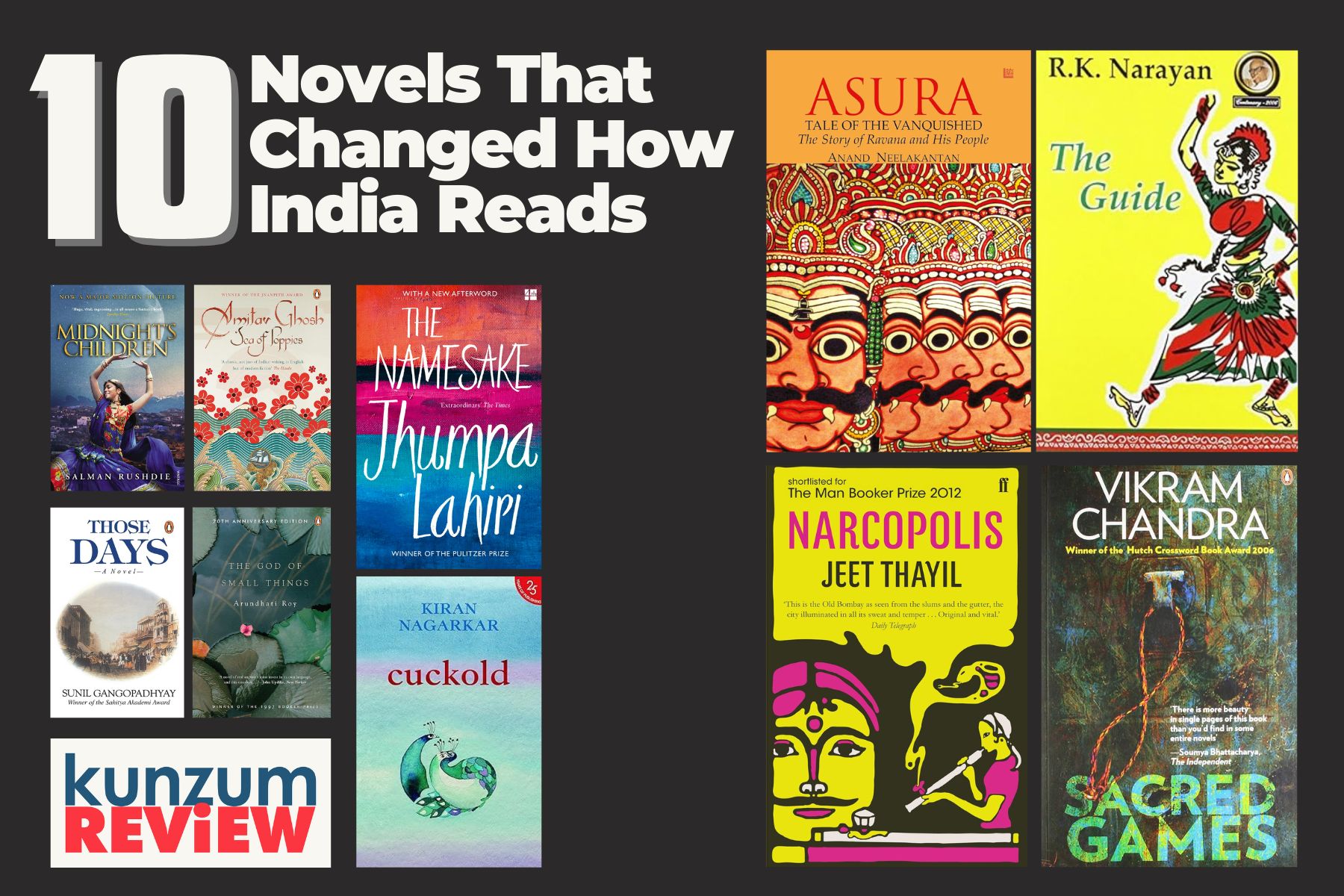
The modern Indian novel has been around for longer than is generally realised, with the earliest attempt at the literary form dating to the 19th century when the Bengali writer Bankim Chandra Chattopadhyay wrote Rajmohan’s Wife — widely regarded as the first English novel by an Indian author. But it wasn’t until the 1930s, with the arrival of Raja Rao, Mulk Raj Anand, and R.K. Narayan, that the novel matured and emerged as a distinct genre within the Indian literary canon. Since then many Indian writers have experimented with the novel form. Here are 10 novels by Indian writers that have shifted India’s literary landscape over the years:

The Guide by R.K. Narayan
The Guide stands out as the greatest of R.K. Narayan’s comedies of colonial self-deception. Set in the fictionalised South Indian town of Malgudi, where Narayan set most of his fiction, this landmark 1958 novel follows the past and present lives of Raju — a corrupt tour guide who falls in love with the wife of one of his clients. Translucently clear and elusive at once, and marked by an ease that masks the complicated nature of its subject matter, the novel explores themes of morality, corruption, greed, and dishonesty in Narayan’s characteristic ironic, understated prose. In 1960, Narayan was awarded the Sahitya Akademi Award for The Guide; and in 1965, the novel was adapted into the Hindi film ‘Guide’ starring Dev Anand and Waheeda Rehman. (Narayan was not a fan of the adaptation and called it ‘the misguided guide’)

Midnight’s Children by Salman Rushdie
Set against the events during and after the partition and independence of India, Salman Rushdie’s 1981 novel ‘Midnight’s Children’ is a postcolonial, postmodern, and magical realist historical fiction about children born with special abilities at midnight on the day of India’s independence. The novel is narrated by Saleem Sinai, one such midnight’s child born with telepathic powers at the exact moment India became an independent nation, and unfolds across the Indian subcontinent — from Kashmir to Agra, and then Bombay, Lahore, and finally Dhaka. Midnight’s Children ushered in a new wave of Indian writing in English, so much so that the decades after its publication are often called the “post-Rushdie” years. Midnight’s Children would go on to win the 1981 Booker, the 1992 Booker of Bookers, and the 2008 Best of the Bookers prizes and become one of the most celebrated and critically acclaimed works of Indian literary fiction.

Those Days by Sunil Gangopadhyay
Sunil Gangopadhyay’s 1985 Sahitya Akademi Award-winning novel Those Days (Bengali: Sei Somoy) is a monumental work of historical fiction set during the 1857 uprising against the British Raj and the Bengal Renaissance. The novel revolves around the lives of the wealthy Singha and Mukherjee families of Calcutta, and Gangopadhyay uses the vast, panoramic canvas of colonial India to reconstruct 19th century Bengali life with the most intimate details and cultural nuances. Yugantar, a popular 80s Indian television drama, was loosely based on Those Days.

The God of Small Things by Arundhati Roy
Arundhati Roy’s 1997 Booker Prize-winning debut novel The God of Small Things is about fraternal twins Estha and Rahel whose lives are torn apart by the pervasive caste and class politics of 1960s Kerala. The novel examines how small, seemingly insignificant events and experiences can produce a ripple effect across time and shape people in deeply significant ways. The novel explores themes of love and sexuality, isolation, the family institution, caste and class politics, and rigid social norms in post-colonial Indian society.

The Namesake by Jhumpa Lahiri
Jhumpa Lahiri’s first novel The Namesake explores many of the same themes as her Pulitzer Prize-winning short story collection Interpreter of Maladies and revolves around the lives of Ashok and Ashima Ganguly and their son Gogol, named after Nikolai Gogol, the Russian novelist, short story writer, and playwright of Ukrainian origin. The novel unfolds across events that take place in Calcutta, Boston, and New York, and examines the nuances of coming of age in-between two conflicting cultures with distinct religious, social, and ideological differences. A film adaptation, also titled ‘The Namesake’, directed by Mira Nair and written by Sooni Taraporevala, was released in 2006 to critical acclaim.

Tomb of Sand by Geetanjali Shree
Geetanjali Shree’s sprawling 2018 novel Tomb of Sand (Hindi: Ret Samadhi) traces the transformative journey of 80-year-old Ma, who slips into severe depression after the death of her husband and decides to travel to Pakistan against the wishes of her family — simultaneously confronting the unresolved trauma of her teenage experiences of Partition, and re-evaluating what it means to be a woman. It was translated into English by Daisy Rockwell in 2021, and became the first novel translated from an Indian language to win the International Booker Prize in 2022.

Asura: Tale of the Vanquished by Anand Neelakantan
The Sanskrit epic Ramayana has been told and retold, written and rewritten many times in many languages across South-East Asia over the years, but Anand Neelakantan’s 2012 retelling Asura: Tale of the Vanquished is one of the rare few narrated from the asuras’ perspective. The novel attempts to highlight the voice of the asuras and the life and struggles of the asura king Ravana as opposed to the victor’s version of Ramayana that paint the vanquished asuras as one-dimensional antagonists. Asura became a bestseller within weeks of its release and helped usher in a new generation of Indian mythological fiction.

Sea of Poppies (the Ibis trilogy) by Amitav Ghosh
Amitav Ghosh’s Ibis trilogy takes places across the tense, tumultuous waters of the Indian Ocean region during the 1830s in the lead-up to the First Opium War between the British Empire and the Qing Dynasty of China and explores the trade of opium between India and China and the trafficking of indentured labourers to Mauritius. Sea of Poppies, the first book of the series, follows the interwoven lives of several characters in 19th century British India, who all, in the latter half of the novel, find themselves taking passage from Calcutta to Mauritius on a schooner named the Ibis. The novel explores themes of patriarchy, casteism, colonialism, imperialism, opium trade, and human trafficking in 19th century India.

Cuckold by Kiran Nagarkar
Kiran Nagarkar’s 1997 novel Cuckold is set in the Rajput kingdom of Mewar, India, during the 16th century and follows the life of Maharaj Kumar, a thinly fictionalised character based on the Mewar prince Bhoj Raj whose wife Mirabai thinks of Krishna as her husband and refuses to accept Bhoj Raj while war ravages the land around them. Nagarkar has been praised for Cuckold’s masterful blending of a traditional narrative against a historical backdrop reconstructed with relentless detail. Widely considered to be a part of the Indian English literary canon, the novel won the Sahitya Akademi Award in 2000.

Sacred Games by Vikram Chandra
Vikram Chandra’s 2006 literary thriller Sacred Games runs on two parallel tracks: one winding through the criminal underworld of Mumbai (then Bombay) in the 1980s and 1990s; and the other through a tense present-day investigation into the meaning of a notorious gangster’s mysterious last words. Sacred Games inspired a new wave of Indian literary thrillers and set a benchmark for Indian neo-noirs to come in its wake. In 2018, the novel was adapted into a limited series of the same name by Vikramaditya Motwane and Anurag Kashyap for Netflix India.
Pick up a book by an Indian author that shifted the literary landscape from any Kunzum store or WhatsApp +91.8800200280 to order. Buy the book(s) and the coffee’s on us.

